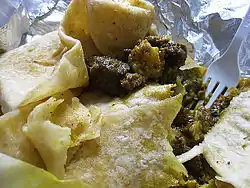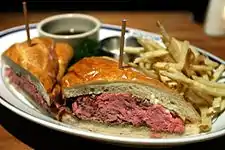Wrap roti
Wrap roti, often referred to as a roti, is a popular food in the Caribbean, and consists of a curry stew folded tightly within a dhalpuri or paratha roti. The stew generally contains potatoes and a meat such as chicken, duck, goat, beef, conch or shrimp.
 A goat and potato roti | |
| Alternative names | Roti |
|---|---|
| Type | Savoury pie |
| Place of origin | Trinidad and Tobago |
| Created by | Sackina Karamath |
| Main ingredients | Potatoes, meat (chicken, duck, goat, beef, conch or shrimp) |
| Variations | Ital roti, Piper roti |
Roti is eaten widely across the West Indies, especially in countries with large Indo-Caribbean populations such as Guyana and Trinidad and Tobago. Originally brought to the islands by indentured laborers from South Asia, roti has become a popular staple in the culturally rich cuisines of Guyana, Suriname, Trinidad and Tobago, Grenada, Jamaica and South Africa. In the West Indies, roti is commonly eaten as an accompaniment to various curries and stews. The traditional way of eating roti is to break it by hand, using it to sop up sauce and pieces of meat from the curry. However, in the West Indies, the term "roti" may refer to both the flat-bread itself as well as the more popular street food item, in which the roti is folded around a savory filling in the form of a wrap.
The "roti wrap" is the commercialization of roti and curry together as a fast-food or street-food item in the Caribbean. This wrap form of roti originated in Southern Trinidad. It was first created in the mid-1940s by Sackina Karamath, who later founded Hummingbird Roti Shop in San Fernando, Trinidad and Tobago. The wrap was convenient as the meal could be eaten faster and while on the go, as well as keeping one's hands from getting dirty. In Trinidad and Tobago, various wrapped roti are served, including chicken, conch, goat, beef and shrimp. Vegetables can also be added including potato, pumpkin, and spinach as well a variety of local condiments; pepper sauce (hot sauce) and mango chutney are the most popular.
The roti wrap quickly gained popularity across the island and spread throughout the rest of the Caribbean. "Roti shops" are now abundant in Trinidad and Tobago and the wrapped roti is a staple street food. The wrap is now simply referred to as roti or just roti. As Caribbeans moved to North American cities such as Toronto, New York, and Montreal, they exported with them the wrapped version of roti. This iconic version is what most North Americans know as roti. The growth in popularity has recently led to referring to the flat-bread itself that surrounds the filling as a "roti skin" or "roti shell." This practice is now common in both restaurants and commercial companies.
Various types of roti are eaten throughout the West Indies. It is most prominently featured in the diets of people in Trinidad and Tobago, Guyana, and Suriname. West Indian style roti is primarily made from wheat flour, baking powder, salt, and water, and cooked on a tawa.
References

